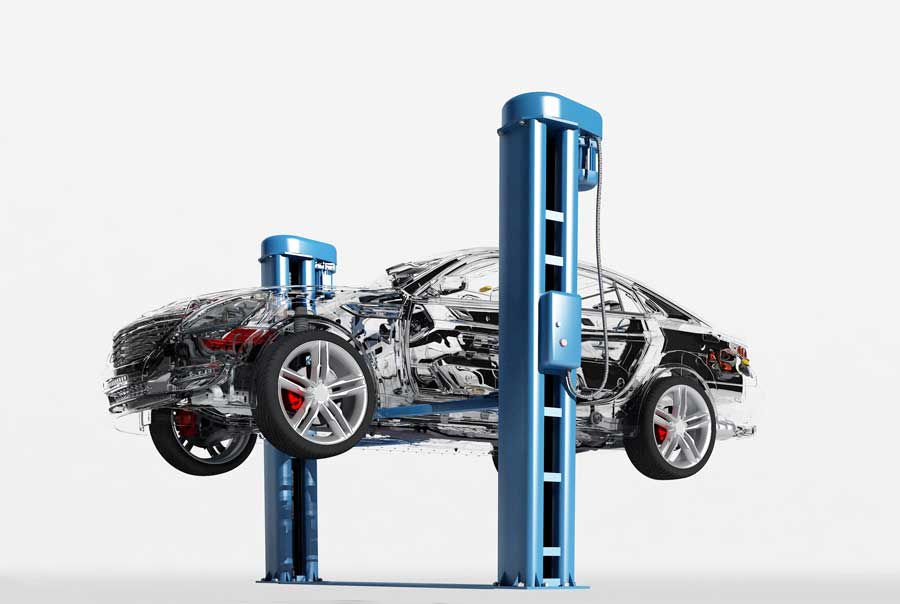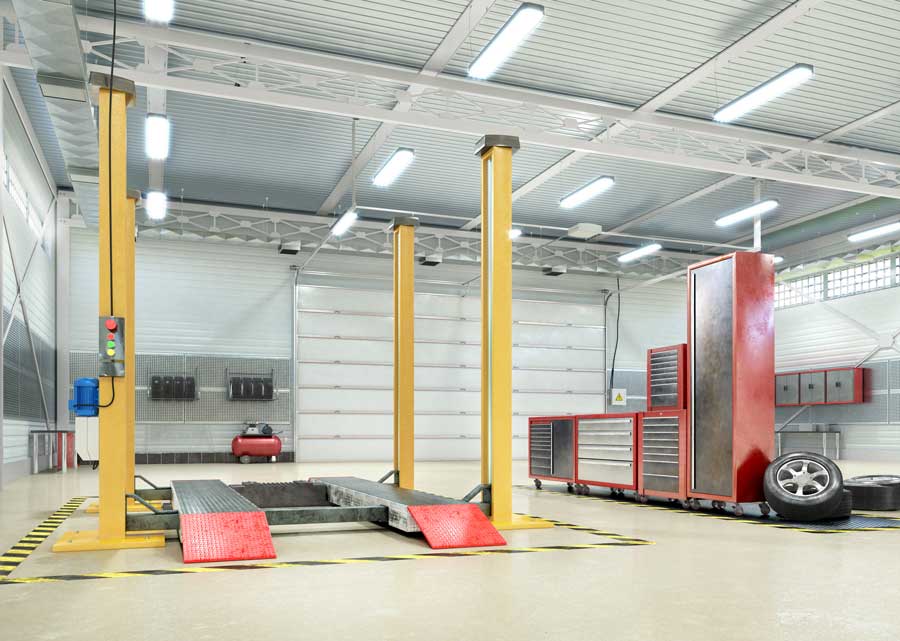Lately, every YouTuber I see is installing a car lift in their home garage to fit more cars. But there’s more to choosing the right car lift for a garage than you might think.
There are various types of lifts: two-post, four-post, scissor lifts, and parking lifts. Each operates differently and has different installation requirements as well.
To install a 2-post or 4-post lift in your home garage, you’ll need a concrete slab of at least 3.5 inches in depth, although many heavy-duty lifts require thicker concrete slabs. Additionally, you’ll need a minimum ceiling height of between 8′ and 13′, depending on the specific model of lift. Scissor lifts require a minimum of 4″ of concrete and 8′ ceilings.
Read on to find out more about car lifts in home garages.

2 Post vs. 4 Post Car Lifts
The two most popular types of car lifts for home garages are two-post and four-post lifts.
As you can imagine, the main difference is how many posts the lift has to support the weight of your car.
The type you need will depend on what you’re lifting and how long you need to keep it in the air.
Two Post Lift
A two-post lift uses two parallel posts to support the vehicle’s weight, balancing the vehicle’s chassis between the two posts at its center of gravity.
You may have seen videos of a car falling off a two-post lift. According to BendPak, one of the major manufacturers of car lifts, that only happens when the vehicle has been lifted incorrectly.
The distance between the posts determines the maximum width of the car that can be lifted.
The posts support on either side of the car work together to raise the vehicle simultaneously. Powerful hydraulics is used to lift and lower vehicles.
Attached to one of the posts are the hydraulic pump and electric motor. This is often referred to as the powered post, while the other is the slave post. Both posts are anchored to the reinforced concrete floor.
You’ll also hear the terms overhead lift and baseplate lift, referring to how the cables and power get from one post to the other.
An overhead two-post lift will have a beam overhead (hence the name) that connects the two posts, whereas a baseplate lift has the connection on the floor.
The beam in overhead lifts turns them into a frame to increase stability. However, the bar limits the maximum height of the vehicle.
Finally, two-post lifts are classified as either symmetrical or asymmetrical.
Symmetrical lifts have two posts facing each other, with each arm supporting about 50% of the load. Asymmetrical lifts have unequal swing arms and are longer in the back than in the front. Because of that, the weight is not shared equally.

Four Post Lift
Four post lifts have two extra columns, hence the name. Although this means they take up more floor space than two-post lifts, they’re more sturdy, easier to operate, and can be used to lift other items besides cars.
Because of the increased stability, four-post lifts are the most commonly used for parking and long-term storage.
Four-post lifts do not require bolting them to the concrete floor, although it’s still recommended. This allows them to be moved relatively easily, provided you’ve got a truck big enough to do it.
There are two variations of four post lifts: open front and closed front.
The difference lies in the presence (or absence) of a crossbar in the front of the lift. Open front lifts don’t have a crossbar, allowing easier adjustment and repairs at the vehicle’s front end.
How to Choose the Right Car Lift for a Garage
Which lift to get depends on how you’re going to use it.
In general, a 2-post lift is great for someone who works on their car but doesn’t need to store it for long periods. Four-post lifts are great for parking and storing vehicles, but they don’t always allow easy access to work on the car from underneath.
While you can use either type of car lift, we recommend four-post lifts for most home garages. Not only are they able to support heavier vehicles, but they often do not need to be anchored to the ground.
This makes them easier to install and can easily be dismantled and moved to a different location. However, if you need something more flexible, a portable car lift may be the answer.
Portable car lifts have a lower maximum weight capacity than two or four-post lifts, but they can be easily moved wherever they’re needed.
How Much Do Car Lifts Cost?
Because of the inherent advantages of four-post lifts, they’re more expensive than two-post lifts, costing around $5000 to $14,000 on average. Two post lifts are cheaper, costing on average between $4000 to $9000. Scissor lifts start at around $3000 and go up from there.
This price depends heavily (pun intended) on the car lift’s weight capacity, but there are several other factors as well.

Concrete Thickness For Car Lifts
Before installing a car lift, your garage needs to meet specific requirements.
Your concrete floor should meet the following criteria:
- It should not have a slope. You can correct minor differences in the slope with proper shimming. Overly sloped floors can be rectified by pouring a new slab.
- New concrete slabs must be cured for 30 days.
- The concrete floor should be reinforced with 300 PSI (pound per square inch) compressive strength.
The height/thickness of the concrete floor depends on the maximum weight the lift can carry.
- Minimum thickness of four inches for a lifting capacity of 8,500 lbs ー10,000 lbs (3856 kg ー4356 kg) lifts.
- Minimum thickness of six inches for a lifting capacity of 11,000 lbs ー 15000 lbs (4990 kg ー6804 kg) lifts.
Most companies recommend increasing the concrete’s strength and depth beyond the minimum, just for safety’s sake.
Besides these requirements, the ceiling needs to be tall and free of obstructions like heaters, beams, and electrical lines. These may cause damage to the vehicle and building.
Each specific model has its own auto lift height. Usually, they require a minimum height of 8′, although heavy-duty car lifts may need up to a 14′ garage ceiling.
Is a Car Lift Worth It for Your Home Garage?
Garage car lifts have several benefits. By their design, they’re taking up space vertically, which means you can take advantage of space that may otherwise have gone to waste.
Some of these benefits include:
Adds Additional Storage
Most homes in the United States have a garage, but studies have shown that around 27% only have a single-car garage. (source)
Why is that a problem?
A different study shows that the average household in America has 1.88 vehicles in it (source). That means that, on average, at least a quarter of the country is parking their cars outside.
Never mind the number of people who can’t park their cars in the garage because they have too much stuff!
One solution to this problem is to expand the garage or add a carport near the driveway. However, this approach can be time-consuming and expensive.
Installing a car lift in your garage provides an easy (and less expensive) solution. Car lifts can be installed in a day and require few if any, modifications to your garage floor.
Most importantly, they let you adapt a one-car garage into a two-car garage and a two-car garage into a three or four-car garage.
Some homeowners even use car lifts to store items other than cars, such as motorcycles, boats, lawn machinery, etc.
Protects Your Car
As I mentioned, it’s common for car owners to park their cars in the driveway when they can’t fit into the garage.
After all, most people can’t afford to rent an airport hangar to store their extra cars.
Even in good neighborhoods, cars left outside can easily get damaged, stolen, or broken into. Besides, continuous exposure to sun and rain will fade the vehicle’s finish faster than usual.
While car lifts don’t directly protect or restore cars, they make those jobs easier to do.
Easy Car Maintenance
Two-post car lifts were initially designed to allow easy access to the underside of a car. This is great for people who enjoy wrenching and repairing their vehicles themselves.
Wrapping It Up
The four posts lifts are ideal for home garages, having a higher weight capacity and being more stable. Installing a home garage car lift is best left to professional installers. This will ensure that the lift is safe and will function as intended.
If you can’t put a lift in your garage, you can usually rent a garage to work on your car. Click the link to see our complete guide for more information.
